Automation & AI: Leveraging Tech to Deliver New Ways of Working
In our second article, we cover the SAVE Framework’s A principle: Automation & AI. By strategically leveraging technology like automation and Artificial Intelligence, manufacturers can maintain operations amid global crisis and disruption.
Since its development, automation for manufacturing has become increasingly critical to ensure new projects efficiently transition from the Proof of Concept stage to fully realized offerings that provide a competitive edge. Today, amid the COVID-19 pandemic, manufacturers sought to implement even more automation. For example, Tesla recently surpassed Toyota, becoming the world’s largest automaker by market value -- no doubt, driven by its acute emphasis on automation (up to 95% in some cases).
Automation for manufacturing has been used in plants since the 1930s. It grew from feedback controller-driven automation in assembly lines leading to car manufacturer Ford Motor Company establishing the first automation department in 1947.
Today, automation in manufacturing falls into three main categories:
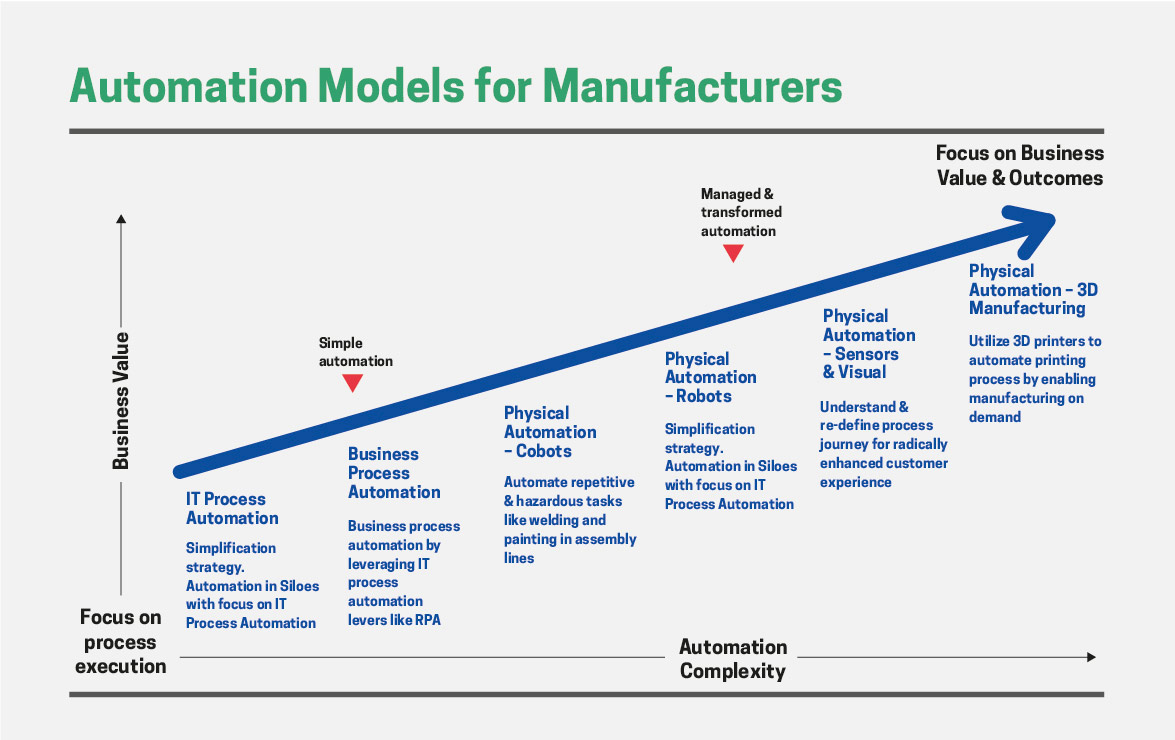
By critically assessing each form of automation and strategically implementing the proper variants, manufacturers can optimize their warehouse operations, create safer environments for employees, and boost productivity and returns.
Physical Automation
Under the physical automation umbrella, there are three sub-categories:
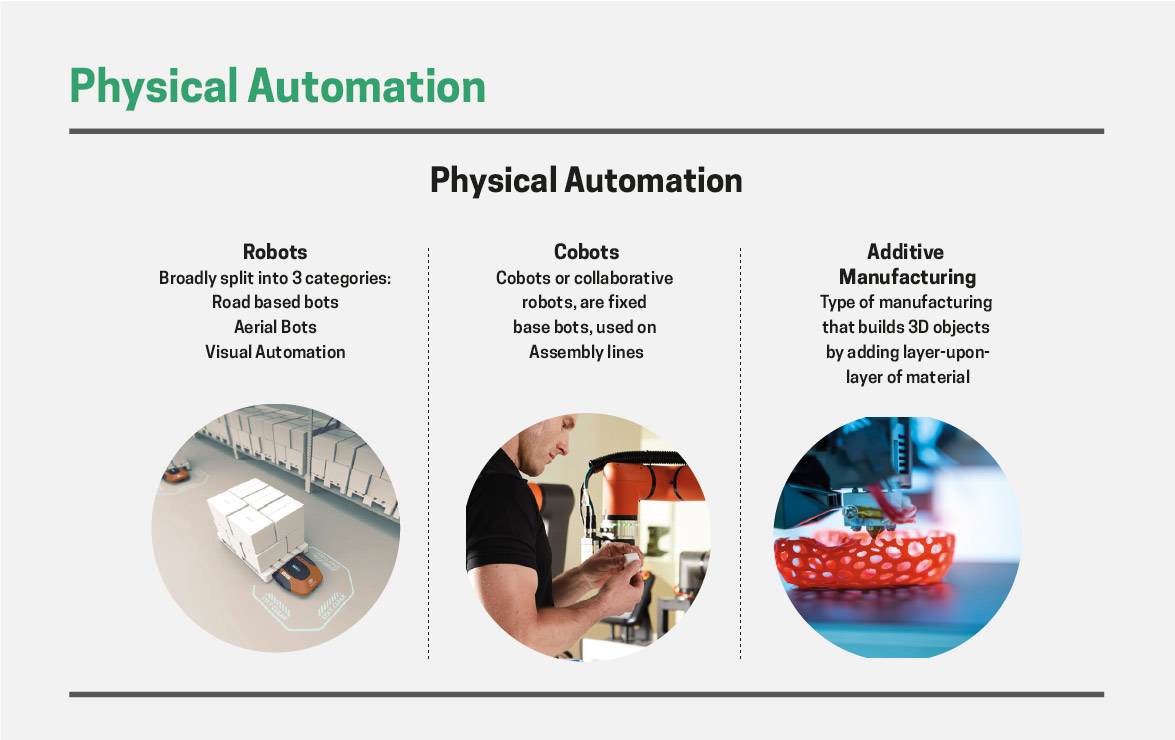
Robots
Road-based robots include autonomous trucks, trailers, tugs, Unit Load Devices (ULDS), and other vehicles used in plants and warehouses to carry heavy loads. While “honeycombing” is a consistent problem at warehouses -- along with warehouse worker safety and material handling issues -- these issues can be resolved by using the autonomous robots to move raw materials, Work-in-Progress (WIP), and finished goods across the plant floor and warehouses.
In conjunction with drones, road-based robots can completely automate the movement of goods in warehouses, ensuring that problems such as “Honeycombing” and employee accidents do not occur in warehouses.
It’s estimated that the payback period for robots can be as short as one year and has an internal rate of return (IRR) potential of more than 30% over three years. Typical centers reduce cost by up to 75%, through labor reduction, waste reduction, and inventory optimization.[1]
Key Benefits:
Aerial Robots are drones programmed to perform autonomous inventory monitoring. Tracking and monitoring inventory, especially when stored within narrow and high-rise aisles, has historically been a problem for warehouse workers. Drones can reduce their workload by monitoring these packages.
Drones can also adapt to a variety of case/pallet storage formats, barcodes, QR codes, and inventory counting processes, as well as integrate with Enterprise Resource Planning (ERP), Warehouse Management and Inventory Management, and Workflow systems. This functionality enables them to adapt quickly to warehouse operations and drive productivity.
Key Benefits:
Visual Automation involves using image recognition technology on images taken by fixed cameras (like CCTV cameras in warehouses) or on-board cameras (i.e. mounted on a drone/vehicle). Visual Automation creates a real-time digital twin of the process. Cameras mounted in the factory floor send data to the IoT platform and then pass it to the Analytics platform for AI analysis and digital twin creation. This technology can track pallets and packages on factory floor through real-time analysis of pallets. Alerts can be configured for factory workers if a pallet hasn't moved based on a defined threshold.
Key Benefits:
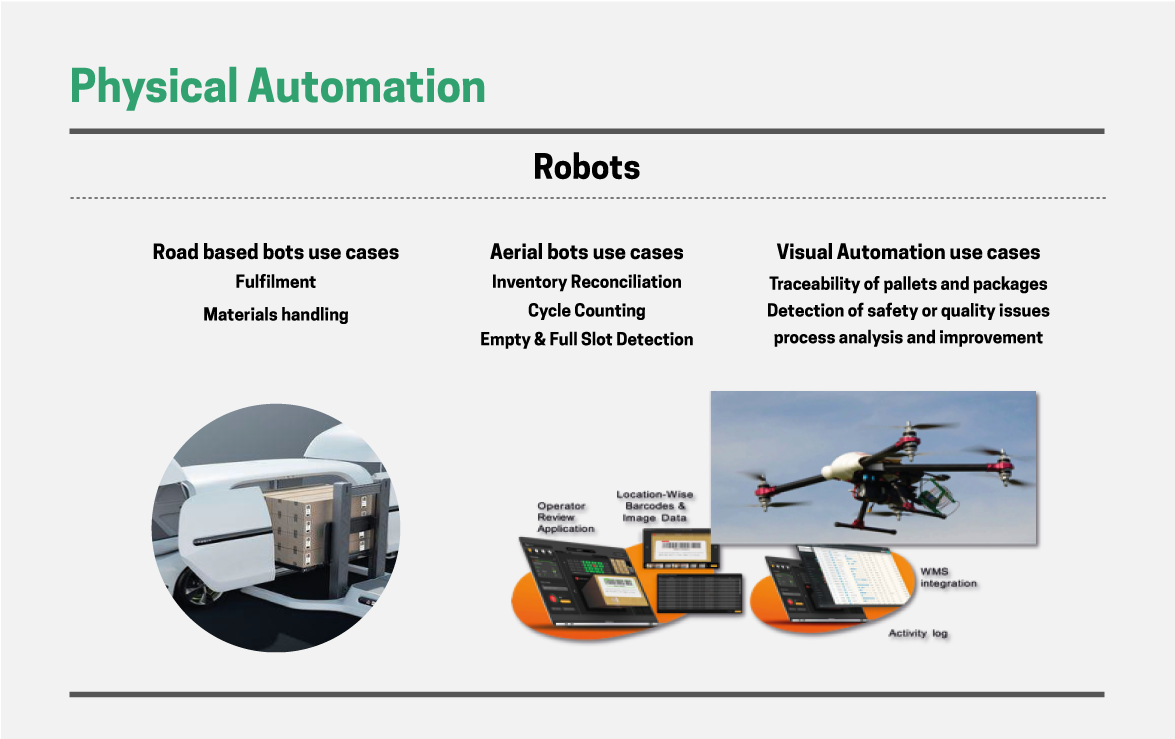
Collaborative Robots
Cobots or collaborative robots are fixed-base bots used on the plant floor. They are intended for direct human-robot interaction within a shared space like assembly lines in manufacturing plants.
Manufacturers often face challenges in employing workers for repetitive tasks. The nature of these jobs can often lead to mistakes, while the repeated physical motions can lead to strain or injury. These tasks can be easily automated by using Cobots, which can perform tasks like welding, drilling, molding, painting, and assembling.
For example, Tiki Safety [2] was able to quickly boost production of its protective respiratory face masks amid the COVID-19 pandemic with the help of Cobots. The bots were programmed to maneuver masks in and out of a machine that molds a sealing rubber strip around the respirator, resulting in ten-times faster production, improved mask quality, and a better environment for employees.[2]
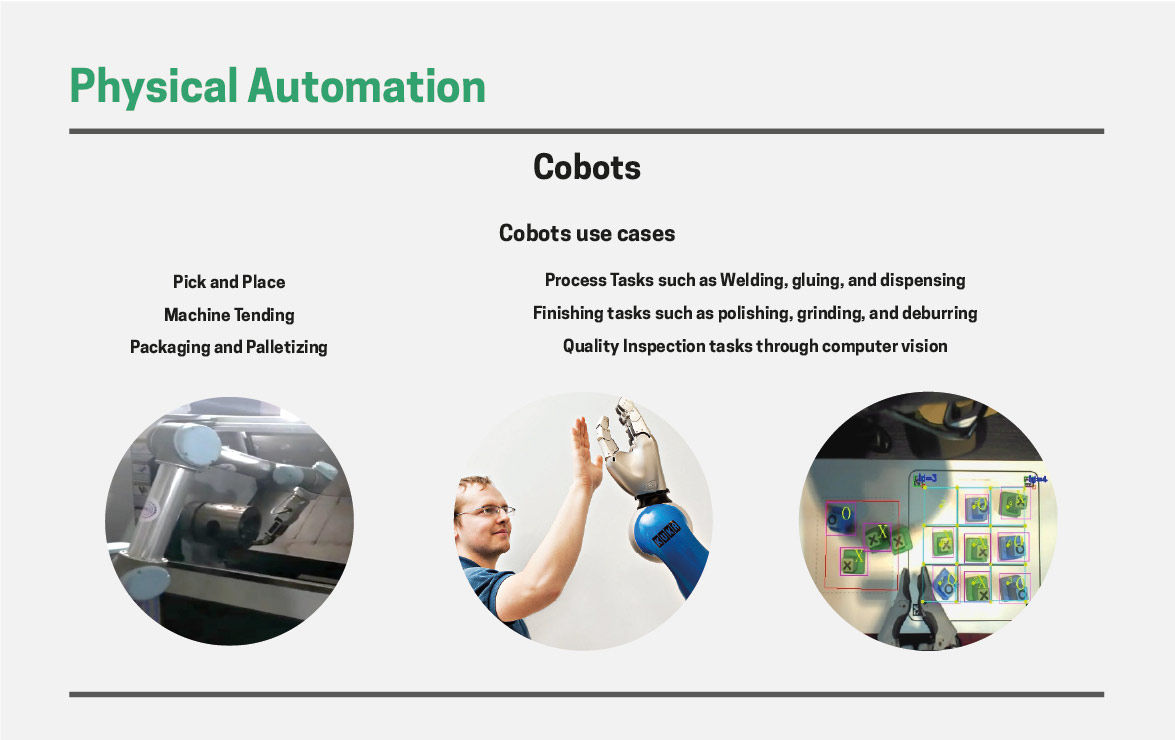
Additive Manufacturing
Additive Manufacturing or 3D Printing involves building three-dimensional objects by systematically layering materials, which range from metal and plastic to concrete and human tissue. This technology runs by creating a Computer-Aided Design (CAD) sketch. Once the sketch is produced, the Additive Manufacturing equipment reads the data from the CAD file and lays downs or adds successive layers of liquid, powder, sheet material, in a layer-upon-layer fashion to fabricate the 3D object. Its uses range from creating intricate production models to fast-prototype testing.
Additive manufacturing is changing the spare parts management industry. Instead of storing spare parts in warehouses for years for huge holding costs, UPS partnered with Fast Radius, to utilize 3D manufacturing. They set up 3D printers in their warehouses and send spare parts out on demand. This drastically lowers holding cost because now only raw materials like metal powders need to be stored, and lead times are reduced because parts are produced closer to delivery locations.[3]
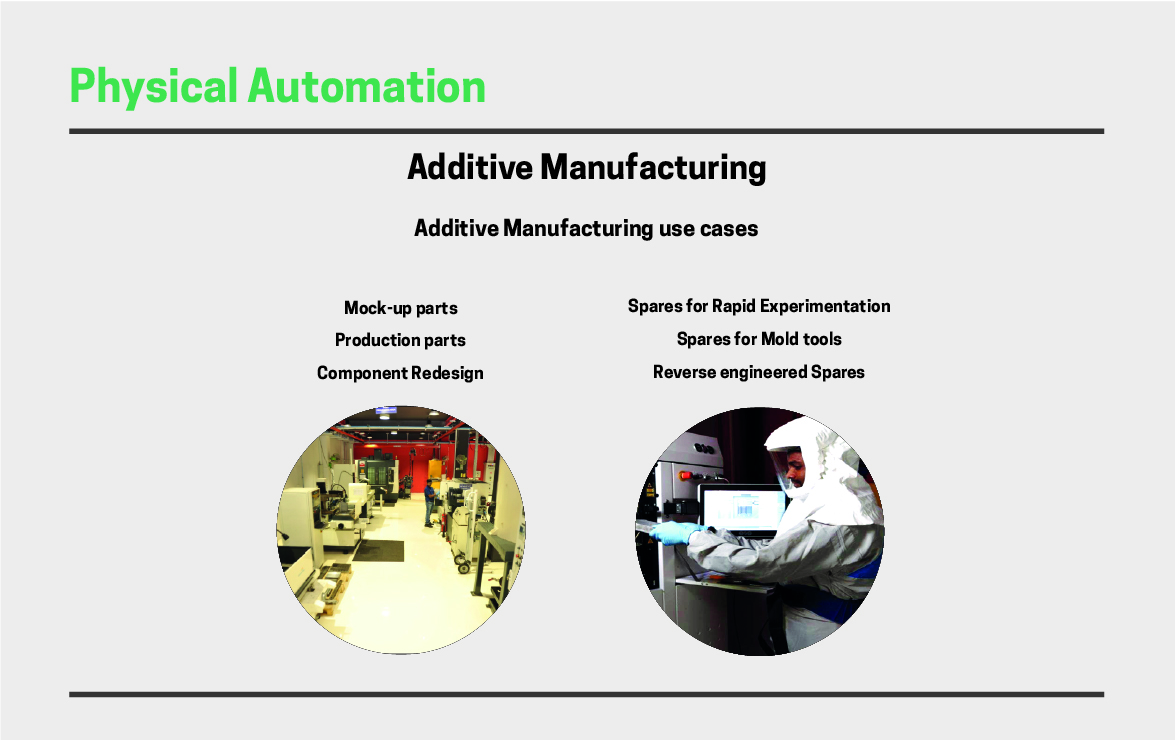
Process Automation
Process automation utilizes digital technology to perform processes that accomplish functions. It’s generally enabled using Artificial Intelligence (AI)-driven automation platforms like Wipro HolmesTM, Blue Prism, Automation Anywhere, and UI Path. These solutions enable faster process resolution and can improve employee productivity.
Key Benefits:
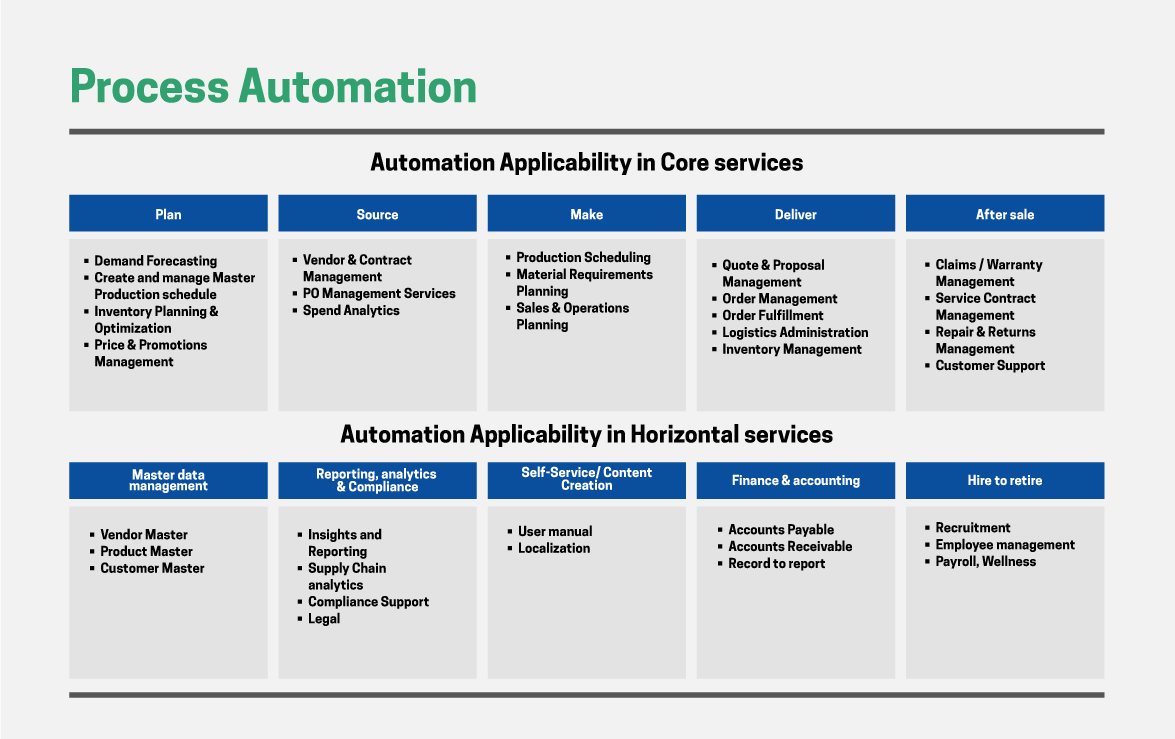
There are a variety of business functions manufacturers can consider when looking to fully or partially automate operations:
IT Automation
IT automation involves using of software to create repeatable instructions and processes that replace or reduce human interaction with IT systems. Automation software works within the confines of those instructions, tools, and frameworks to carry out tasks with little to no human intervention. Similar to process automation, this functionality focuses on enhancing IT processes.
IT Automation is also available in as-a-Service models enabling manufacturers to experience the benefits of automation for specific services at an optimized rate. These models include Network Automation as a Service model, which provides features like automated configuration management, event-driven automation, lifecycle management, network provisioning automation, build automation, and more.
Key Benefits:
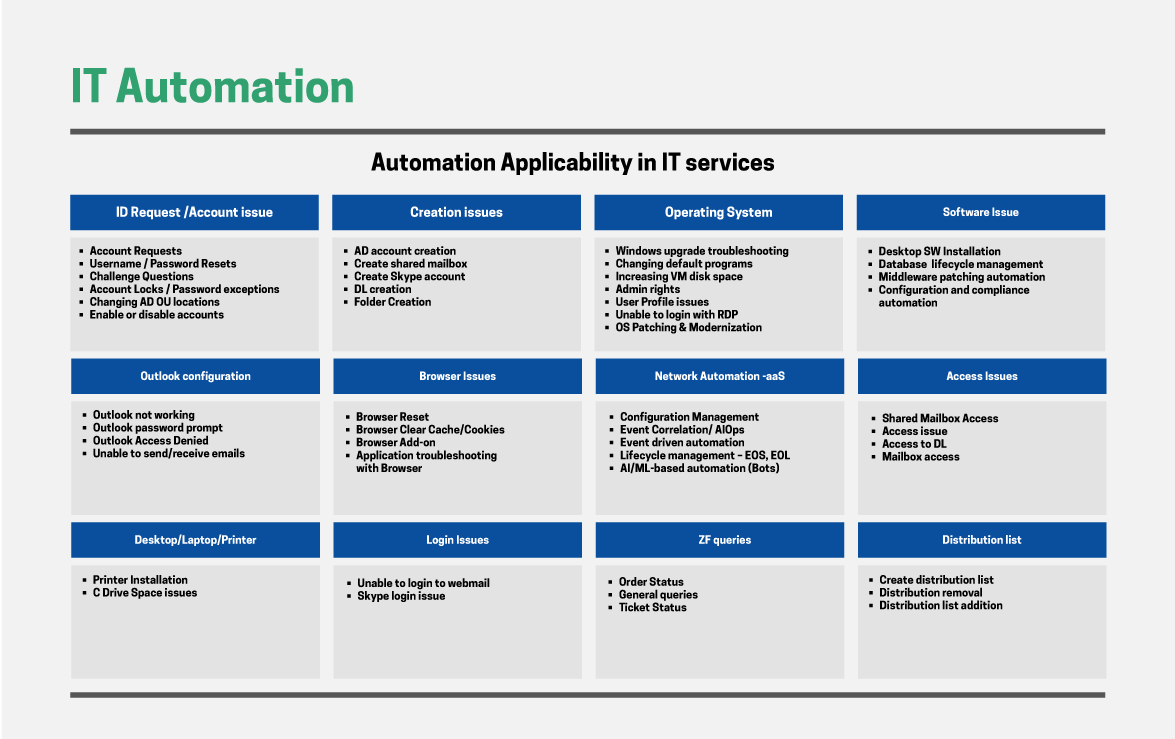
The SAVE Framework Approach:
The COVID-19 pandemic has impacted manufacturers differently -- from complete plant shutdowns to repurposing plants to manufacture essential equipment like ventilators. These shifts have impacted revenue heavily, and automation for manufacturing is one way costs can be stabilized going forward.
By partnering with Wipro, your manufacturing organization can strategically implement automation can now while productivity is low and employees are working remotely or on furlough. It’s also an ideal time to train associates on these new forms of technology.
We’re equipped to help manufacturers begin this journey, whether it includes identifying small opportunities across the or implementing automation across the entire organization. Here’s our approach:
Physical Automation
Process Automation
IT Automation
If you’re interested in learning more about the SAVE Framework and how you can optimize your manufacturing enterprise, check out the other three articles highlighting this special optimization approach. Or, if you have questions or would like to set up your obligation-free assessment, contact us today to begin.
References:
Namit Bhargava
GM & Head of Digital Sales, Digital Transformation
Passionate for results, Namit Bhargava brings innovative strategic perspective on Digital Transformation and Industry X.O themes for superior Customer Experience. Namit is a thought leader for CXO conversations for topics including digital strategy, transformation, new business models, and innovation.
Connect with Namit on LinkedIn
Savish Sadanandan
Senior Consultant, Digital Solutions
Savish Sadanandan is Senior Consultant focusing on bringing Digital Solutions across the Manufacturing Value Chain. Savish likes to analyze and understand the Client's pain points to identify linchpins which can drive Digital Transformation.
Connect with Savish on LinkedIn